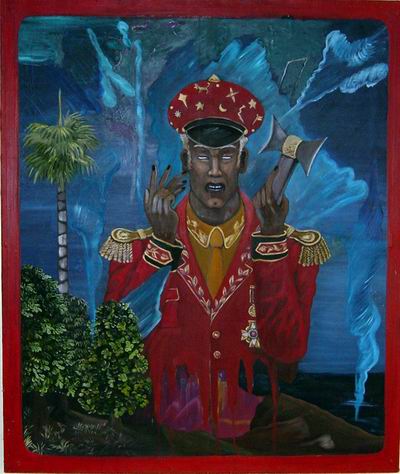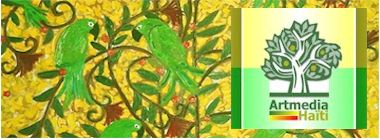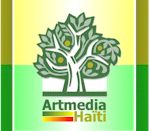|
General C
I love working! Yes, I�m under pressure but I can say no to an exhibition. But, I have an agenda and I love activity. During the last two or three years, my work has been in demand for all sorts of things.
 |
- This whole thing plays to the two sides of my life, the two sides of what I am, and the two aesthetics I am battling with everyday. The western aesthetics and the black aesthetics - EDC
Edouard Duval-Carrie at the Miami Art Museum and Bernice Steinbaum
by Paula Harper
Edouard Duval-Carrie was born in Haiti, but when he was a child, his family fled Papa Doc Duvalier's regime. He studied in Montreal and at the Ecole des Beaux-Arts in Paris before moving to Miami. From this long perspective he explores the theme of "Migrations" in his new paintings, sculptures and installations.
In Miami, migration is a major item on the evening news. Thousands of Cubans have arrived since the Mariel mass exodus, many in small, makeshift rafts. Rickety boats loaded with desperate Haitians continue to be intercepted; the bodies of those who drown have washed up on our beaches. Jose Bedia, one of the best known of Miami's Cuban emigre artists, obsessively fashions schematic compositions using Afro-Cuban-Indian symbols to evoke his own transit from the Caribbean to the urban mainland. Duval-Carrie's version of the theme projects not a personal narrative but his reflection, spiced with humor and political bite, on a long tradition of sacred images. He cheerfully appropriates the traditional folk style of Haitian painters and the island's pantheon of Voudou gods and goddesses ("loas" in Creole), and he uses both style and symbol to comment on political and cultural realities.
At the Miami Art Museum, Duval-Carrie created an installation that filled the New Work Gallery. It included a wall inspired by the architectural format of a Renaissance altarpiece, inset with sculpted figures in niches and round, square and rectangular paintings, all of modernized Voudou deities, which like the ancient gods can be seen as personifications of nature and of human types and temperaments. Erzulie, for example, the Ioa of love akin to the Greek Aphrodite, is updated as a gaudy exotic nightclub dancer. This hybrid wall demonstrates migration of styles and ideas; migration as the movement of peoples is evoked in the larger-than-life Ioas with flocked surfaces in hot colors who sit disconsolately in a flotilla of wooden boats hanging in midair. They represent Baron Samedi, spirit of death and sex, Erzulie, spirit of female power, and others. In Duval-Carrie's imagination, everyone is leaving a desolated Haiti, even her presiding spirits.
At Steinbaum, Duval-Carrie showed, along with a small installation, an explosive array of large, emblematic paintings in sea greens and blues heated with Caribbean magentas, reds and oranges. The figures and symbols are as flat, frontal and linear as Byzantine icons; the intricate floral backgrounds tame jungle vegetation into elegant patterns. In some compositions, Duval-Carrie includes a group of tiny palm trees at the right of the image and on the left, a cluster of skyscrapers as the destination of the silhouetted boatload of migrants who traverse the lonely space between.
Several paintings allude to the political and social history of Haiti. Confiserie Sucre Noir (Black Sugar Confections) refers to French' control of the sugar industry through the importation and use of black slaves. It parodies the kind of picture that could advertise the brand name of such a product on an 18th-century candy box. Against the background of a wallpaper pattern of repeated black heads, the black face in the center, fixed in place by a lacy collar, hovers above a flowery hemisphere.
Duval-Carrie presents his canvases in wide, wooden frames that become part of the painting-as-object. Some frames show remnants of a gold-leaf Rococo decoration (Duval-Carrie uses a stencil sold by Ralph Lauren to produce a "traditional" effect) on which layers of tropical sea-blue resin encroach, studded with carved emblems like hearts, anchors, infants and Haiti's royal palm tree. His frames increase esthetic distance, emphasize the artfulness of the images they contain and, like all of Dural-Carrie's pensively comic work, suggest the palimpsest of history.
COPYRIGHT 2001 Brant Publications, Inc.
COPYRIGHT 2001 Gale Group
- Edouard Duval-Carrie
- Size: 52x44 Framed
- Medium: Acrylic
- Support: Canvas
- For Sale by Private Collector
|







